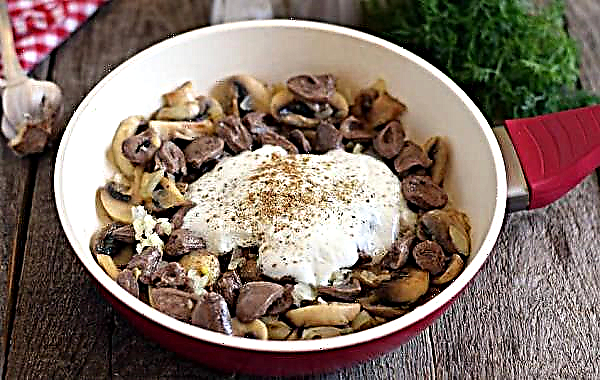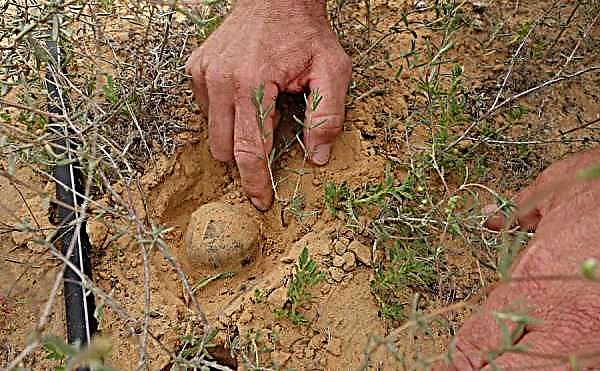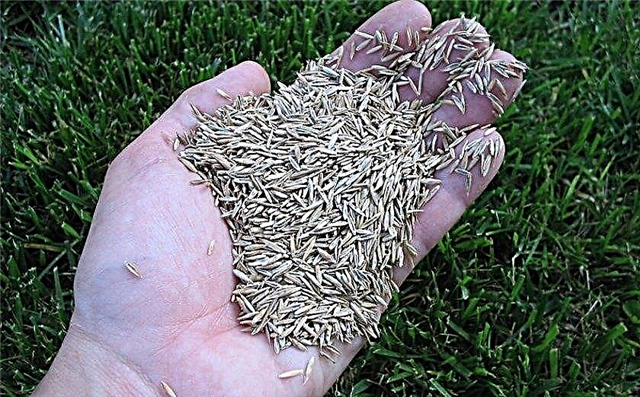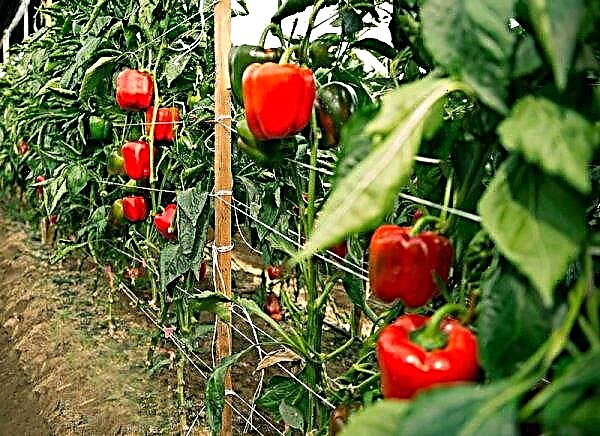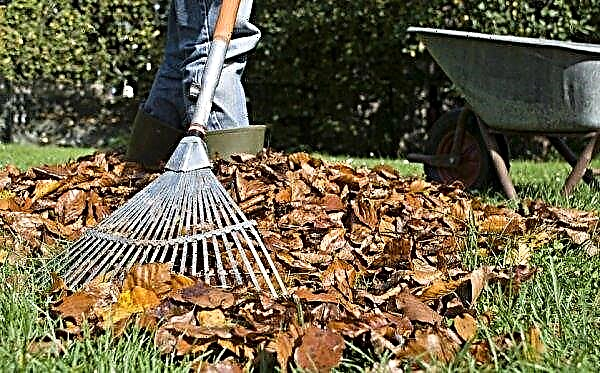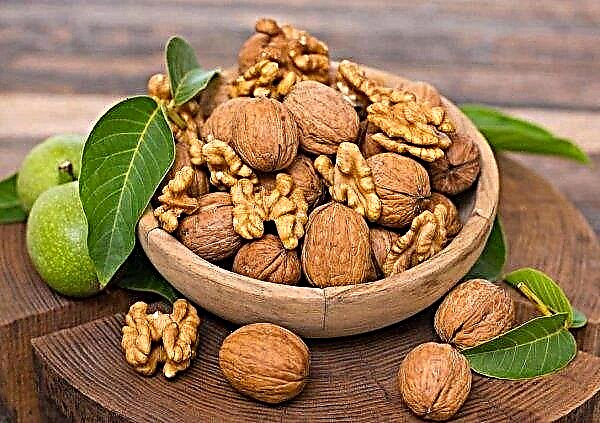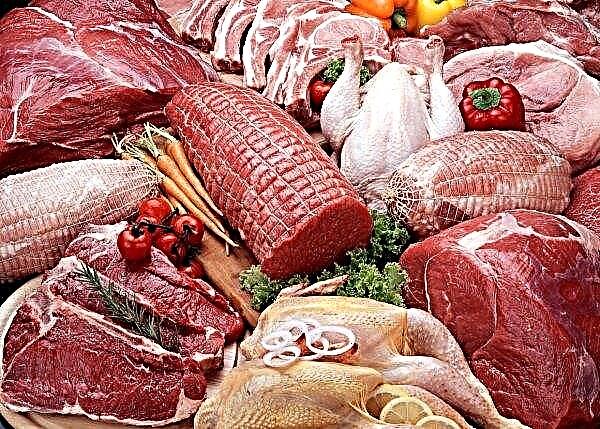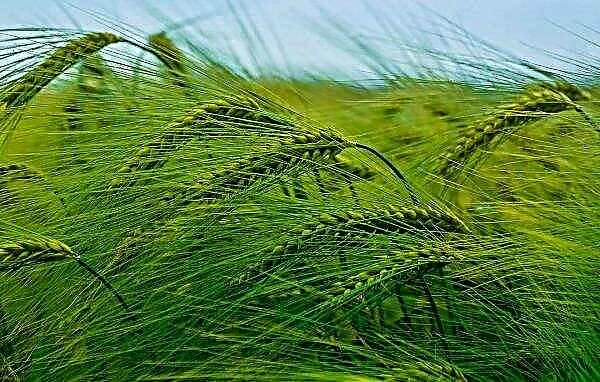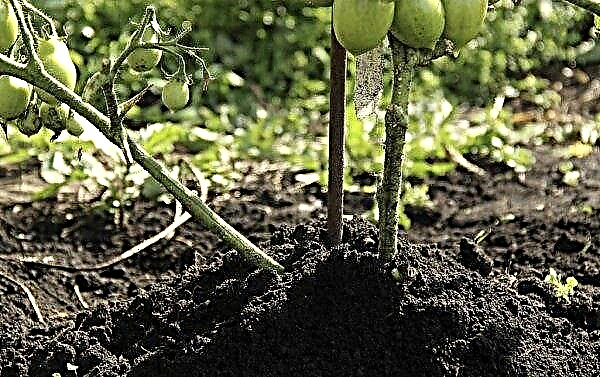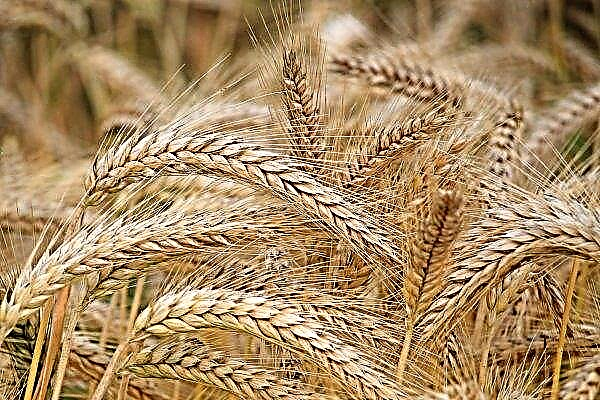It is rare that a summer cottage or garden is dispensed with beds of garlic. This healthy vegetable with a pungent taste and pungent odor is often grown for your own purposes or for sale. The cultivation of spring or shootless garlic in the open ground will be discussed in this article.
The best varieties of spring garlic for growing
Features of the spring type of garlic are:
- low productivity compared to winter species;
- excellent keeping quality;
- Suitability for long-term storage;
- bulb with a random arrangement of teeth;
- lack of arrows.
 This species is grown in spring. Harvested in late August - early September. In order to achieve maximum yield, you must correctly select the variety of this vegetable crop.
This species is grown in spring. Harvested in late August - early September. In order to achieve maximum yield, you must correctly select the variety of this vegetable crop.Did you know? The healing properties of garlic were known to the ancient Egyptians. In manuscripts relating to the period of existence of Ancient Egypt, there are 800 prescriptions for medicines, 22 of which contain the organs of this vegetable plant.
In the open ground
The most popular varieties for planting on open beds include:
- Victorio: the weight of the bulb is 40 g, 13-15 teeth in one onion, the taste is semi-sharp, is used fresh, suitable for canning.
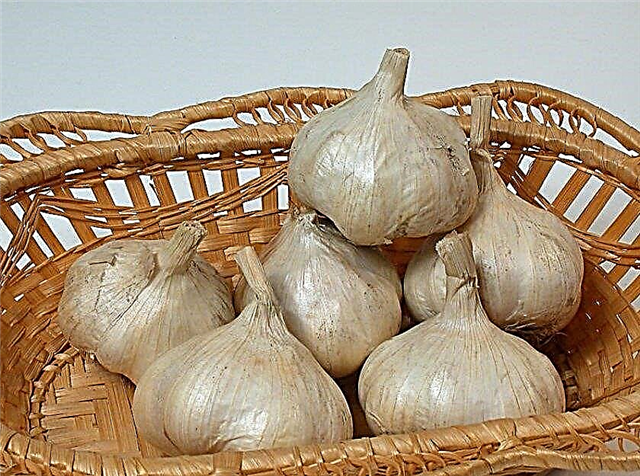
- Gulliver: the mass of the head is 90–120 g, the bulb contains 4–5 teeth, acute, universal use.

- Elenovsky: the mass of the head is 17–23 g, in the bulb there are 15–18 teeth, peninsular, suitable for fresh and canned use.
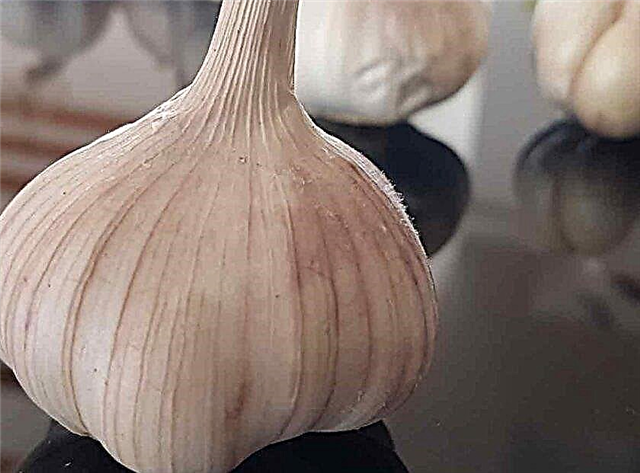
- Abrek: the mass of the head is 30 g, the number of teeth is 15, sharp, it is used fresh in cooking and can be cooked.
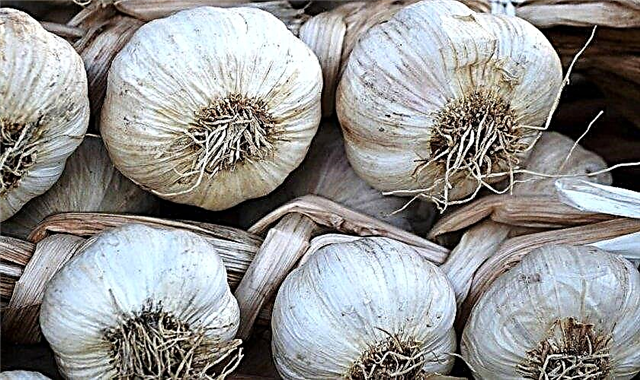
- "Aleysky": the mass of the head is 17 g, it has 15-18 teeth, sharp, grown for universal use.
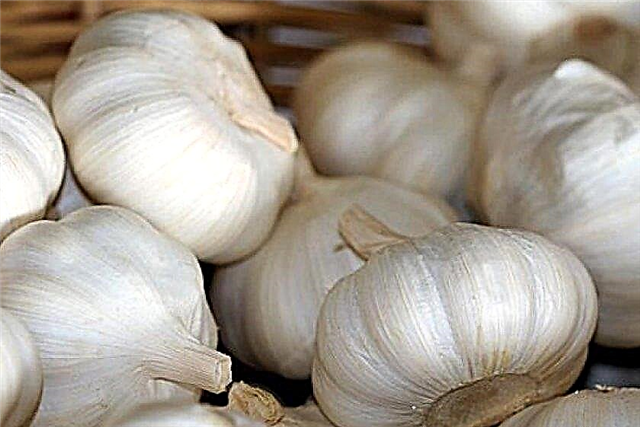
In the greenhouse
In closed conditions, one spring variety is most often cultivated - "Gafuri". Its head reaches a weight of 32–64 g. One bulb contains 16–18 cloves. Their taste is spicy.
Planting spring garlic
To grow spring garlic, little teeth are planted in the ground. For planting, large planting material is selected, weighing at least 3-6 g. The teeth should be intact and resilient.
Important! It is not necessary to select teeth for planting from the heads, where they contained only 2-3 pieces. Such are not able to give a good harvest, since they are considered degenerate.
Landing time
In order to find out when to plant garlic in the spring, it is necessary to measure the temperature of the soil at a depth of 10 cm. It should not be lower than +5 ... + 7 ° С. Planting times will vary depending on the region where the vegetable crop is grown. So, in the middle lane it is planted at the end of April, in the northern regions - closer to the beginning of May. If the temperature will slightly decrease after being placed in the ground, this is not scary. Garlic is able to withstand conditions when lowering the thermometer to +4 ... + 10 ° C. In greenhouse conditions, garlic can be planted in early April. For him, it is necessary to create conditions with a constant level of air humidity of 65–70%, temperature - not less than +25 ° С.
If the temperature will slightly decrease after being placed in the ground, this is not scary. Garlic is able to withstand conditions when lowering the thermometer to +4 ... + 10 ° C. In greenhouse conditions, garlic can be planted in early April. For him, it is necessary to create conditions with a constant level of air humidity of 65–70%, temperature - not less than +25 ° С.
Choosing a place in the garden
The plot for garlic should be selected sunny, in extreme cases, half-shaded. A plant growing in a well-lit bed will produce large heads. Planted in partial shade will please with abundant greenery.
The site should be previously cleared of weeds. Lowlands where water stagnates should be avoided. It is also necessary to pay attention to the fact that the site is not blown by the winds, because garlic does not respond well to sudden temperature changes.
Important! If the garden is small, then garlic can be planted on the same site with strawberries. These plants get along well with each other and do not compete for nutrients.
To minimize the risk of developing diseases, invasion of parasitic insects, and also to achieve maximum yield, it is necessary to adhere to crop rotation rules. This means that garlic should not be planted more often than 2 years in a row in one area, as well as after plants that are affected by the same diseases and pests. Garlic can be returned to the previous beds no earlier than after 4–5 years.
- Based on crop rotation rules, the best predecessors for this vegetable are:
- cereals (oats, barley);
- winter crops (clover, alfalfa);
- legumes;
- zucchini;
- squash;
- cucumbers
- early cabbage;
- pumpkin.

- You can not plant a vegetable after such plants:
- bow;
- carrot;
- garlic;
- beet;
- potatoes;
- radish;
- eggplant.
- Garlic is a useful neighbor for:
- Strawberries
- wild strawberries;
- currants;
- gooseberries;
- roses;
- gladioli;
- tulips.
Its pungent odor can scare away harmful insects from these plants.
Important! Separate the bulbs into the cloves immediately before placing them in the ground. Otherwise, the bottom will dry up, and this will negatively affect the yield.
Soil preparation
Garlic feels great in fertile loams with a neutral pH level. It needs to be well moistened. 2 days before planting, they dig a site on the bayonet of a shovel.
Then feed the soil with a mixture of:
- 3 glasses of wood ash;
- 5 l of rotted compost;
- 2 tsp complete mineral supplement.
 This amount of fertilizer is designed for 1 m². Next, prophylactic treatment from pests is carried out - a well-moistened soil is poured with saline (3 tbsp. / 10 l of water). Immediately before planting, the soil is leveled with a rake.
This amount of fertilizer is designed for 1 m². Next, prophylactic treatment from pests is carried out - a well-moistened soil is poured with saline (3 tbsp. / 10 l of water). Immediately before planting, the soil is leveled with a rake.Preparing planting material
Opinions of experts on whether to clean teeth before planting differ. Some recommend this procedure. Others argue that planting material should be placed in the soil in an unpurified form. Gardeners are united in one thing - before planting it needs to be dried for 14 days.
It is useful to perform long-term stratification by holding planting material in cold conditions for 2-3 weeks. After stratification, the teeth are discarded, leaving only healthy, large and intact.
A day before being placed in the soil, the planting material is disinfected - treated with a 1% solution of copper sulfate or a weak (pink) solution of potassium permanganate. For processing also use a solution of wood ash (450 g of ash boil 30 minutes in 5 l of water).
After filtering the solution, the teeth are kept in it for 2 hours. After processing, they are washed with warm water. You can also germinate the teeth before planting, wrapping them in a damp cloth and polyethylene and placing them in the refrigerator at temperatures of +8 ... + 10 ° С for 2-3 days.
Landing technology
To properly plant spring garlic, you must adhere to the following instructions:
- In the soil, make furrows with a depth of 3-5 cm at a distance of 25-30 cm from each other.
- Place the teeth in the soil with the bottoms down, observing the intervals of 6-8 cm.
- Sprinkle planting material with earth.
- Tamp the soil.
- To carry out plentiful watering (if the earth is dry).
- Mulch using straw, sawdust, compost, peat, humus. The recommended layer of mulch is 2-3 cm.

Cultivation and care
Spring garlic is easy to care for. Regular watering, periodic top dressing, soil care, and, if necessary, treatment for diseases and parasites will be required.
Important! Planting spring garlic can be placed in the aisles of carrots or early potatoes. With their smell, they scare away the carrot fly and the Colorado potato beetle.
Fertilizers and watering
Garlic loves plentiful watering. They must be produced as the topsoil dries. On dry days, about 10-12 liters of water per 1 m² will be required. In August, watering will need to be stopped - at this time the head begins to grow actively and gain mass.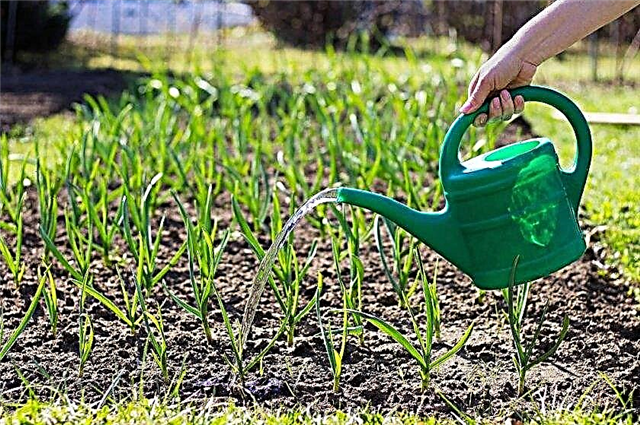 For spring garlic, 4 dressings per season will be required. For the first time, fertilizers are introduced at the stage of emergence of sprouts. Mullein, bird droppings (1:10) or urea will be required. The following feeding is carried out with an interval of 14 days. At this time, additives are added that contain phosphorus and potassium. A well-proven aqueous solution of wood ash.
For spring garlic, 4 dressings per season will be required. For the first time, fertilizers are introduced at the stage of emergence of sprouts. Mullein, bird droppings (1:10) or urea will be required. The following feeding is carried out with an interval of 14 days. At this time, additives are added that contain phosphorus and potassium. A well-proven aqueous solution of wood ash.
Weeding and cultivating the earth
Since garlic does not tolerate the proximity of weeds, it is necessary to control the cleanliness of the beds and, if necessary, remove the grass with the root. This must be done carefully so as not to damage the heads underground. Mulching of the soil will allow to get rid of carrying out frequent weeding.
Care should be taken when loosening. This procedure must be carried out as often as possible, always after each irrigation and rainfall. It allows you to improve the moisture and breathability of the soil.
Did you know? Documentary sources contain information that workers in the construction of the famous Egyptian pyramids were given garlic to increase their strength and endurance.
Pest and Disease Control
With errors made during planting and care, spring garlic can affect a number of diseases and pests.
Most often, the plant has such diseases:
- White rot. When infected with a pathogen fungus, the leaves turn yellow and die, the roots are covered with white mycelium. In order to prevent the development of the fungus, at the beginning of the growing season they are treated with the Fitosporin-M fungicide.
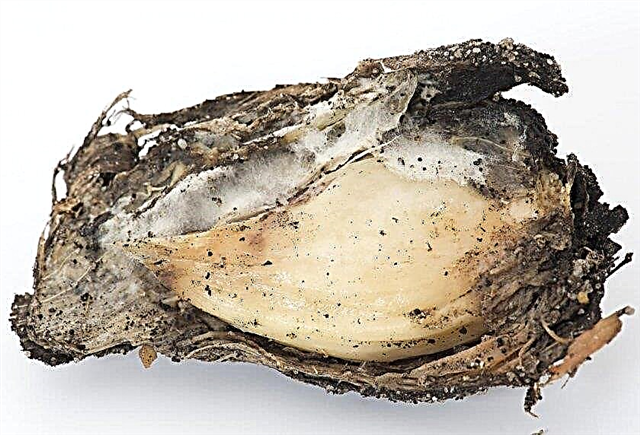
- Cervical rot. A characteristic feature is white spots with a green border at the bottom of the stem and gray spots on the bulb. The treatment is carried out with Fundazol.
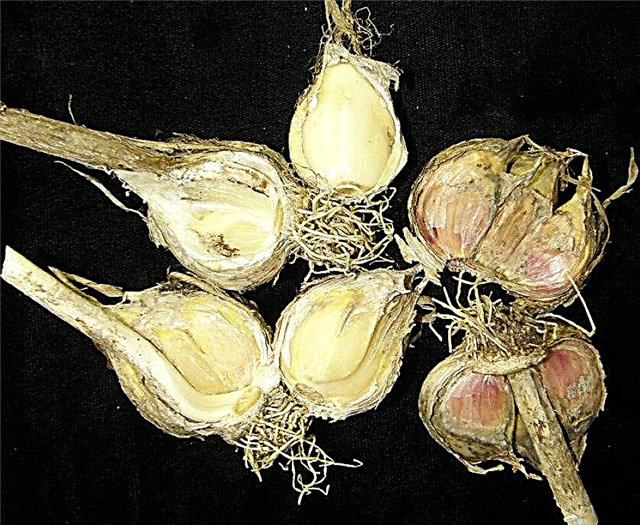
- Downy mildew. Symptoms - yellowing, deformation, wilting of the stem, slowing plant growth. The fight is carried out by the fungicides "Tiram", "Polycarbocin", "Arceride", "Polychom", 1% Bordeaux liquid.

- Fusarium In case of damage, the stems turn yellow and dry, pink or yellow plaque forms in the axils of the leaves, and the roots rot. For treatment, the treatment is used with Hom, Fitosporin, Quadrice.
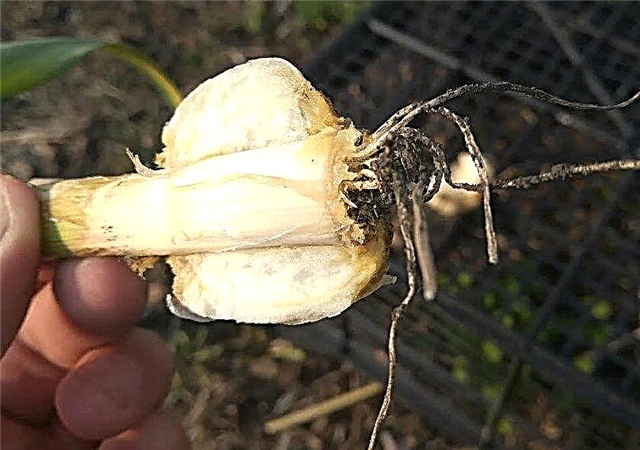
- Rust. It is manifested by the formation of small rusty spots on the leaves. The treatment consists in spraying with copper sulfate, the preparation “Khom” with an interval of 2 weeks.
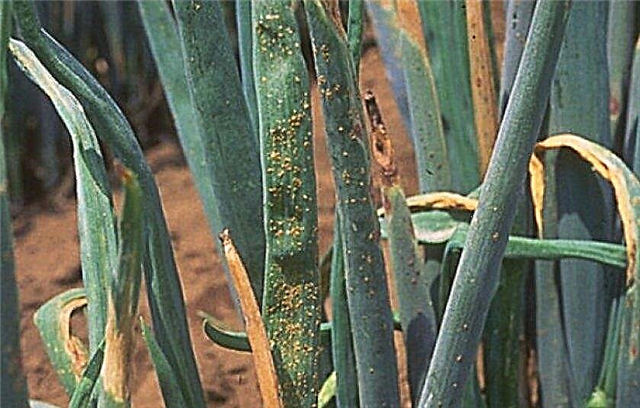
- Viral mosaic. The disease is manifested by wilting leaves, the appearance of yellow spots on them. This viral disease is not amenable to treatment.
Important! 30 days before harvesting, processing plants using chemicals must be discontinued.
Of the pests for vegetables are dangerous:
- Root ticks. The treatment is carried out by treatment with the drug "Colloidal sulfur."
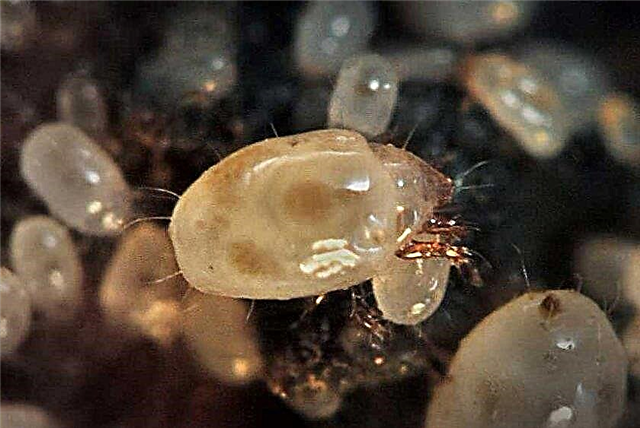
- Weevils. To scare away the parasite from the beds, chopped wood ash, dry mustard, ground pepper are sprinkled between the rows.
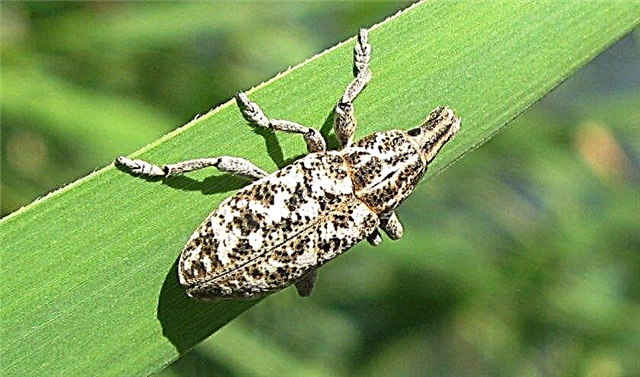
- Onion moths and flies. For the fight, folk remedies are used: saline irrigation, dusting with a mixture of wood ash, tobacco dust and ground pepper, treatment with Bazudin, Iskra.

- Stem nematodes. To scare off planted next to the calendula. For treatment, "Carbation", "Tiazon", "Vidat" are used.

- Tobacco thrips. To prevent the growth of the population of these insects, loosening is applied with a mixture of wood ash, pepper and mustard added to the ground.
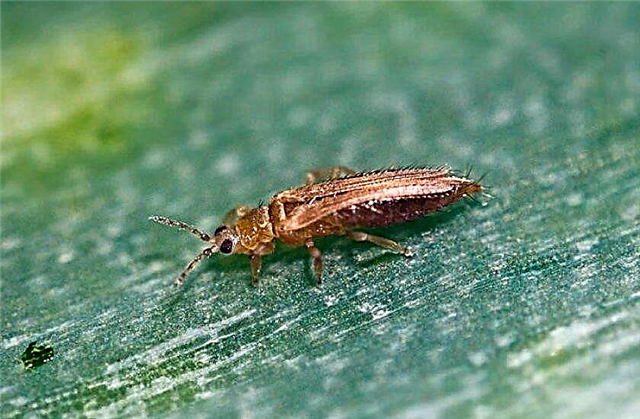
- Onion grub. To get rid of the pest, treatment with the means of "Tiofos", "Heptachlor", 1-2% solution of creolin is used.

It is important to prevent the development of diseases. Chemical treatments are extremely undesirable for garlic, because the head absorbs both nutrients and toxic substances.
Among the preventive measures:
- compliance with crop rotation rules;
- carrying out all necessary agricultural activities;
- careful selection and disinfection of planting material and soil.
Harvesting and storage periods
Garlic is harvested from the 15th of August to September 10th.
The fact that a vegetable plant can be removed is indicated by the following symptoms:
- new feathers do not form;
- feathers became yellow, lay on a bed;
- bulbs are fully formed, have a characteristic color and size;
- the husk is easily removed;
- juicy flesh.
Did you know? When ingested, garlic is capable of exerting antibacterial, antifungal, antiviral, anti-inflammatory, anti-malarial, antioxidant effects on the human body.
Harvesting is carried out using a pitchfork or manually on a sunny day in the morning or evening hours. After extracting from the soil, the vegetable is left on the ground to dry for several hours. After the earth has dried and falls off well, the heads are shaken off and again placed for drying under a canopy at a temperature of +25 ° С for 10 days or for 7 days in a room with good air circulation and temperature indices of +30 ... + 35 ° С . Sunlight should not fall on the bulbs. When the garlic dries well, the roots and foliage are cut off from it, leaving a stalk 5 cm long.
Spring garlic is stored at a temperature of +16 ... + 20 ° С and humidity of 60–80%. It can be:
- tie for stems;
- braid in braids;
- put in nets, fabric bags;
- hanging to the ceiling;
- put in baskets, glass containers, wooden boxes.
The shelf life depends on the variety - it can be from 10 months to 2 years.
So, it’s easy to grow spring garlic. The main thing is to choose a high-yielding variety, to carry out the correct planting and to produce quality care. This vegetable plant can be cultivated on open and closed beds. Under properly organized conditions, it can be maintained without losing its valuable properties for 1–2 years.


















